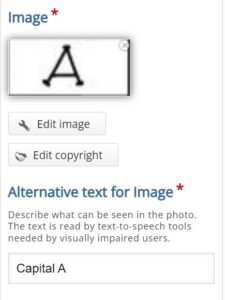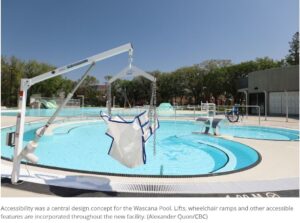I found our discussion on accessibility and equity interesting and eye-opening. As a person who has privilege in this area, I have not had to think about accessibility for myself and therefore I realized I might not be thinking about it for my students. I thought the Boston University Article did a great job outlining some accessibility considerations when teaching remotely or online. The idea of being flexible was outlined in this article. Be flexible with how students can participate and demonstrate their learning. Be flexible in choosing your resources. I think that sometimes being flexible can be hard for teachers who are trying to build a course and meet the curricular outcomes. But when we provide options for students, we provide them with an overall better experience online and it benefits their mental health.

Photo: Security Magazine
Reflecting on the course I am currently building I think it is accessible in terms of access to technology. Since it is being used in an in-person classroom all the students will have access to the same technology, the same internet, in the same space. Therefore, limitations such as lack of technology, power, and the internet do not apply. I have tried to make the course as easy to maneuver as possible, however, I do feel like this is an area I might need to see be done in practice in order to really get a picture of if it will work for my age group of students. When creating the assignments in Lumi I did not pay a lot of attention to things like “alternate text” but after our discussion, I made sure to go back and add picture descriptions and I now see the importance of including those for visually impaired students and I will continue to take the time to add those in. I appreciate that Lumi allowed for click-and-click instead of dragging which makes it more accessible for students who are unable to drag with their fingers.

An area I wish that I could have done more with is adding voice recordings or pictures to the activities. This would especially be helpful for my students who are younger but also for any student who may have a learning disability and requires extra help to read/ understand the problem or task.
As stated above I think that when implementing this course, I need to remain flexible. If I have a student who cannot complete an activity I need to understand why and think about what changes I can make to help their experience with the content. This mindset can be translated into all areas of life. As we discussed in class, what might do to help one person may actually help the whole community. This concept reminded me of the new Wascana pool that has opened. They put emphasis on making the park/pool accessible for the community. When reading about the accessibility implementations they created you wonder why we have taken the time to do these things in more places. Simple changes make such an impact on those who need it. I think it requires I shift in thinking of changes as more work and instead, we see it as an opportunity to create something that will benefit all students.

Photo: CBC News
Moving forward I will be thinking more about my own accessibility practice whether that is as a teacher, as a student, or a community member.
How are you thinking of incorporating accessibility measures into your own course and activities?

Great post and well thought out! Within my course, I will use text readers online like Google Read & Write and Read Aloud. Further, students have opportunities to use different apps for reading, speaking and communicating like Seeing AI and Proloquo2go. Further, ensuring everything is laid out in a simple manner, where students do not feel overwhelmed with all the content. Ensuring students know their expectations and their roles before beginning. Have you had any experiences with these apps?
I have only used Proloquo2go, I am interested in looking into google read and write a bit more. I agree I think ensuring it is not overwhelming is one of biggest hurdles to overcome. We want it to be a good experience for the students but also for ourselves!
I thoroughly enjoyed your blogpost , well presented Specially how to discussed the section in your blog about being adaptable in resource selection. I firmly believe that being flexible can be difficult for teachers who are trying to develop a course while meeting curricular outcomes. However, when you provide kids options, they have a better online experience, which enhances their mental health.looking forward for more blogpost!